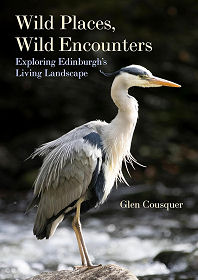 |
"Wild Places, Wild Encounters: Exploring Edinburgh's Living Landscape" by Glen Cousquer is an inspirational book, one of those all-too-rare books that leave you wanting to go out and explore what you've learned from it on the ground: to experience for real what you've read about between its covers.
In his introduction, the author says: "This guidebook has been written to help us all learn to slow down, wake up and appreciate the green spaces and wildlife we can still encounter in and around Scotland's capital city. In doing so, we also find ourselves waking up to and recognising the extent to which the UK has become one of the most nature-depleted and impoverished countries in Europe." He also explains how to use the guide: "This book presents 14 different walking routes carefully chosen from across the Edinburgh area to provide you, whether an armchair reader or a walker yourself, with a rich variety of seasonally flavoured and opportune encounters with nature. This will mean you can visit a range of habitats and explore a rich tapestry of socio-cultural and natural history."
The book is beautifully produced and a real pleasure to handle and to read. Each walk is in effect a chapter in itself and starts with a brief introduction and a large, clear, attractive and helpful map with the walking route clearly marked on it. We then get a summary, history, other background information and a set of well-written directions illustrated with colour photographs and enlivened by information about the flora and fauna you are likely to encounter on the walk. Amongst the routes included are some within Edinburgh itself, such as Corstorphine and Blackford Hills and Salisbury Crags; and others outwith the city itself, such as Aberlady Bay, the Dalmeny Estate and the River Almond from Cramond.
The publishers' description of the book gives a good sense of what the author has achieved: "This is a book about reconnecting to nature wherever we find ourselves living and the personal benefits that can ensue. It explores how we can appreciate the natural world on our doorstep in line with the latest research from a range of disciplines, including ecology, outdoor and environmental education, learning for sustainability and mindfulness studies. It does so by means of a blend of encounter-based photography, connection with nature and reading the landscape. There has been a tendency for people to lose contact with nature. The industrial growth society generated a catalogue of ecological disasters including acid rain, the hole in the ozone layer, the sixth mass extinction and climate collapse. Slowly, we are waking up to the fact that this society is fundamentally extractive and exploitative and the burden of costs has shifted onto the environment and future generations. In appreciating and understanding the enormity of this crisis, we risk compounding it with the mental health crisis that is sweeping the globe. Healing that relationship requires us to slow down and to seek reconnection with nature which can help revitalise and sustain us. Life passes by all too fast when we are oblivious to nature's presence and are unable to be fully involved in nature. Wild Places, Wild Encounters provides the means to break this cycle. The book's essence is essentially about reconnecting with and learning to relate to nature as explored in these wanderings through the green heart of Scotland's capital city and the wild nature reserves of the Lothians. Nature is still there, all around us."
InformationPaperback: 256 pagesWhittles Publishing www.whittlespublishing.com 28 June 2024 Language: English ISBN-10: 1849955719 ISBN-13: 978-1849955713 Size: 24 x 17 x 2 cm Buy from Amazon (paid link) Visit Bookshop Main Page |
